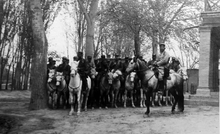
Back Rebelión islámica en Sinkiang (1937) Spanish شورش اسلامگرایان در سینکیانگ (۱۹۳۷) Persian Исламское восстание в Синьцзяне (1937) Russian Sincan İslam Ayaklanması (1937) Turkish 1937年新疆战争 Chinese
This article needs additional citations for verification. (August 2010) |
| Islamic rebellion in Xinjiang (1937) | |||||||||
|---|---|---|---|---|---|---|---|---|---|
| Part of the Xinjiang Wars | |||||||||
 Abdul Niyaz with his soldiers in Kashgar | |||||||||
| |||||||||
| Belligerents | |||||||||
|
Muslim Turkic rebels |
| ||||||||
| Commanders and leaders | |||||||||
|
Kichik Akhund Abdul Niyaz † |
| ||||||||
| Units involved | |||||||||
|
| |||||||||
| Strength | |||||||||
|
~10,000 Chinese Muslim cavalry and infantry 1,500 Turkic rebels |
5,000 Soviet Red Army troops Several thousand White Russian soldiers and provincial Chinese troops | ||||||||
| Casualties and losses | |||||||||
| ~2,000 casualties |
Provincial government: ~500 Soviet and White Russian forces: ~300 | ||||||||

In 1937 an Islamic rebellion began in southern Xinjiang. The rebels were 1,500 Uighur Muslims commanded by Kichik Akhund, who was tacitly aided by the New 36th Division, against the pro-Soviet provincial forces of the puppet Sheng Shicai.[1][2]
- ^ "Moslems in Chinese Turkestan in Revolt Against Pro-Soviet Provincial Authorities". The New York Times. 26 June 1937.
- ^ Forbes, Andrew D. W. (1986). Warlords and Muslims in Chinese Central Asia. Cambridge, England: CUP Archive. ISBN 978-0-521-25514-1.